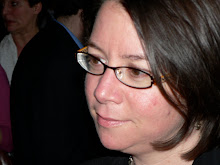I can’t stop thinking about what it must have been like to encounter this place by surprise – to be out on a journey and find…. holes in the ground roaring sulfurous steam? Fountains of boiling poison water blasting a hundred feet in the air? Gentle (boiling poisonous) springs trickling out of terraced pools sculpted from mineral icicles, colored with algae? Not to mention the gorgeous mountains and lakes and waterfalls and canyons. The whole thing is superlatively dramatic.
We started at Mammoth Hot Springs, where the hot water carries dissolved limestone that deposits onto the surface, changing the ground shape by an inch or more per month. You walk on long boardwalks through the moonscapes of the dry areas.
Then, in the areas with active springs, multicolored “thermophiles” (heat-loving microorganisms) tint the water in strong oranges and yellows. Their intricate growth combines with the crystal buildup of the limestone to make boggling patterns, like things you might find on another planet. And in fact they think we might find them on another planet: scientists study these specialized chemical environments for clues about possible extraterrestrial life. Super weird.
Everywhere you go there are hot springs, geysers, fumeroles (steam holes), and mud pots. The hot springs are often really beautiful, with twisty tunnel shapes in the clear blue depths, looking like the coolest swimming pool, only it’s hot.
At mud pots, the sulfuric acid in the water dissolves the rock into gloppy mud, and the gas blurps up through it. Rather like boiling pudding. The kids find it hilarious and actually so do I. [We took movies, but Blogger can't seem to handle them, sorry.]
Geysers can bubble, spray, or just steam ominously. Fumeroles are just holes in the ground where gas escapes, but somehow they are the spookiest of all; they often make cavernous hooting or roaring or rumbling sounds, and you wonder what the hell is about to come out of there. Aaron does not like them at all. He doesn’t like anything that steams, in fact, and has to be carried long distances when we are among geysers. It helps a lot if he calls them by different, non-scary names: beysers, gweisers, schmeisers, etc. (Language is so weirdly powerful.) Jordan, on the other hand, cannot get enough. To him they are volcanoes, and wonderful. He wants more geysers every day.















No comments:
Post a Comment